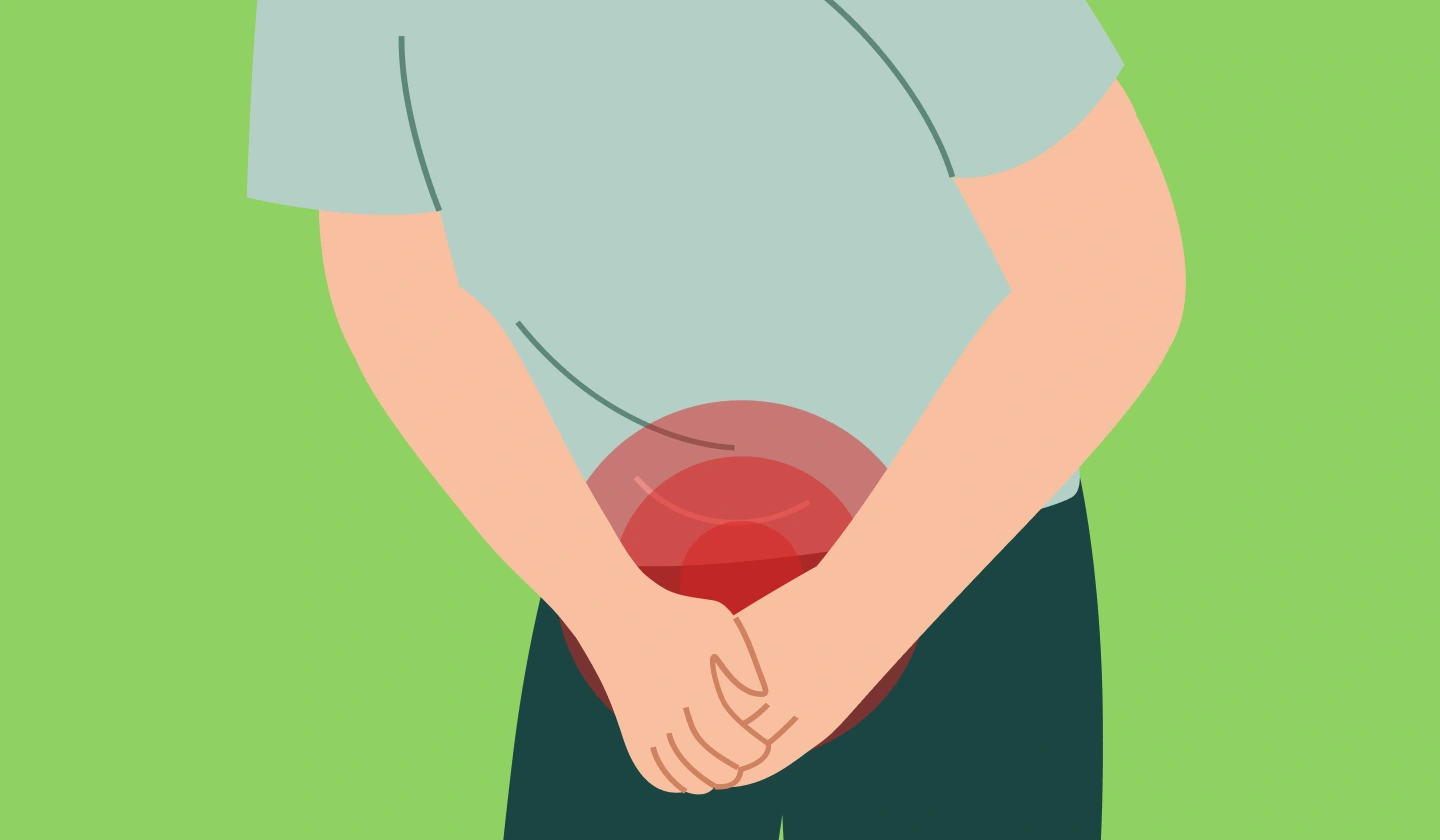
If you’ve been struggling with persistent pelvic pain, discomfort while urinating, or sexual symptoms that simply refuse to go away, you’re not alone. Many men in Pasadena experience similar frustrations, unsure why their symptoms keep returning despite multiple treatments. Chronic prostatitis, also known as Chronic Prostatitis/Chronic Pelvic Pain Syndrome (CP/CPPS), is a condition that can affect men at any age. Studies show that around 10% of men will experience prostatitis-like symptoms during their lifetime.
What’s surprising is that approximately 97% of these men do not actually have a bacterial or bladder infection, even though antibiotics are often prescribed. In most cases, the issue isn’t caused by infection. Instead, it stems from tension or dysfunction in the pelvic floor muscles. When these muscles become tight, inflamed, or uncoordinated, they can mimic the symptoms of a prostate disorder.
That’s why so many men in Pasadena who have been told they have chronic prostatitis find real relief through pelvic floor physical and occupational therapy. At PHRC, our specialized pelvic floor physical and occupational therapists focus on addressing the root cause of your pain. By improving muscle function, restoring balance, and easing tension throughout the pelvic region, we help you move toward lasting relief and recovery.
What are the Causes of Chronic Pelvic Pain Syndrome in Men?
Chronic Pelvic Pain Syndrome is rarely caused by an actual infection in the prostate, despite what many men are told. Instead, there are several possible sources of discomfort, most of which involve how the pelvic floor interacts with other systems in the body.
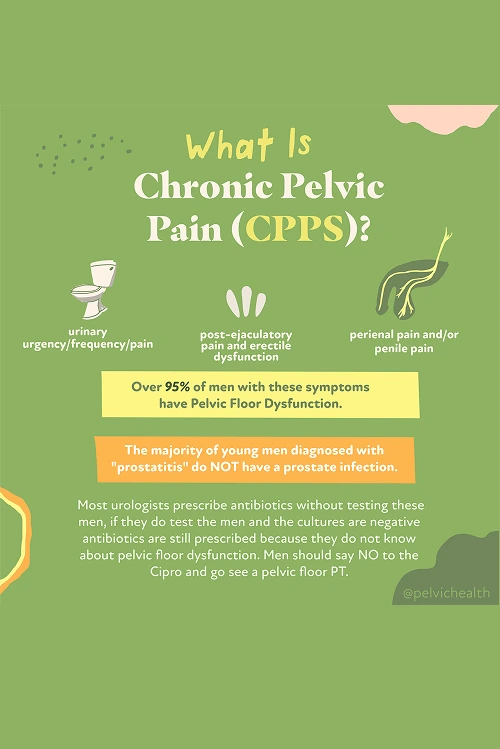
- Lumbar pathology: The nerves that supply the pelvic region originate in the lower back. If a lumbar disc bulges, arthritis develops, or a nerve becomes irritated, the resulting pain can radiate into the pelvis or feel as though it is coming from the prostate, even though the underlying problem is in the spine.
- Vascular pathology: Circulatory problems in the pelvis, such as varicoceles, venous congestion, or altered blood flow, can produce sensations of heaviness, pressure, or aching that closely mimic prostate discomfort.
- Pelvic floor pathology: The pelvic floor muscles form a supportive hammock beneath the pelvis. When these muscles tighten, spasm, or lose proper coordination, they can irritate nerves and produce pain that seems to originate from the prostate or bladder. In truth, dysfunction in the pelvic floor muscles is often the primary driver of the symptoms.
Other contributing factors can include:
- Past surgeries such as vasectomy or prostate procedures
- Structural issues like hip dysfunction, scoliosis, or leg length differences
- Excessive or sudden changes in exercise
- Long hours of sitting
- Chronic constipation or frequent straining
- Trauma or stress to the pelvic area
Although several factors can play a role, the majority of men who experience persistent pelvic pain, especially when it involves urinary or bowel issues, tend to have pelvic floor dysfunction at the core of their condition.
Symptoms of Chronic Pelvic Pain Syndrome
The symptoms of CPPS can be confusing and discouraging because they often mimic a prostate or bladder condition, even though the root cause may actually lie in the pelvic floor muscles. If you’re experiencing CPPS, you may encounter one or more of the following:
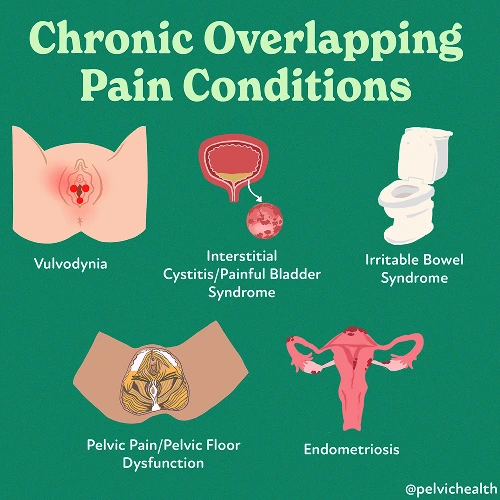
- Aching, pressure, or sharp pain in the perineum, pubic area, or lower abdomen
- Discomfort that feels like it’s coming from the testicles, tip of the penis, or inside the urethra
- Urgency, frequency, weak stream, or the sensation that you can’t fully empty your bladder
- Burning or stinging, even when no infection is present
- Pain with or after ejaculation, erectile discomfort, or reduced sexual satisfaction
- Tightness or aching that overlaps with pelvic discomfort
- A sense of heaviness, pressure, or tight muscles in the pelvic floor area
Associated Diagnoses
Chronic pelvic pain experienced by men can result from a combination of well-documented health conditions, some of which involve the spine, others the blood vessels, and many the muscular structures of the pelvic floor.
Spinal complications such as lumbar nerve irritation, slipped discs, or arthritic changes can radiate discomfort into the pelvic region, presenting similarly to prostate pain. Circulatory issues like varicocele, venous congestion, or torsion of the testicle can alter normal blood flow, leading to aching, heaviness, or stabbing sensations. While Chronic Pelvic Pain Syndrome remains the most frequently seen diagnosis, pelvic floor dysfunction frequently overlaps with pudendal neuralgia, painful bladder syndrome, and sometimes with hard flaccid syndrome.
In many situations, pelvic floor dysfunction becomes the primary connector, either producing pain on its own or amplifying symptoms that originate from spinal or vascular disturbances.
Diagnostic Challenges
One of the most challenging parts for men with CPPS is simply getting an accurate diagnosis. Many are told they have prostatitis and are prescribed antibiotics, even though no infection is actually found. Studies have shown that more than 90% of men who experience pelvic or genitourinary pain do not have a bacterial infection of the prostate.
Instead, most cases fall under the National Institutes of Health (NIH) Category III classification of prostatitis, which refers to Chronic Prostatitis/Chronic Pelvic Pain Syndrome. The NIH categories are as follows:
- Category I: Acute bacterial prostatitis (true infection, sudden and severe)
- Category II: Chronic bacterial prostatitis (chronic infection, often with repeat UTIs)
- Category IIIa: Inflammatory CPPS (white blood cells seen on testing, but no bacteria)
- Category IIIb: Non-inflammatory CPPS (no white blood cells or infection, but symptoms are present)
- Category IV: Asymptomatic inflammatory prostatitis (inflammation without symptoms)
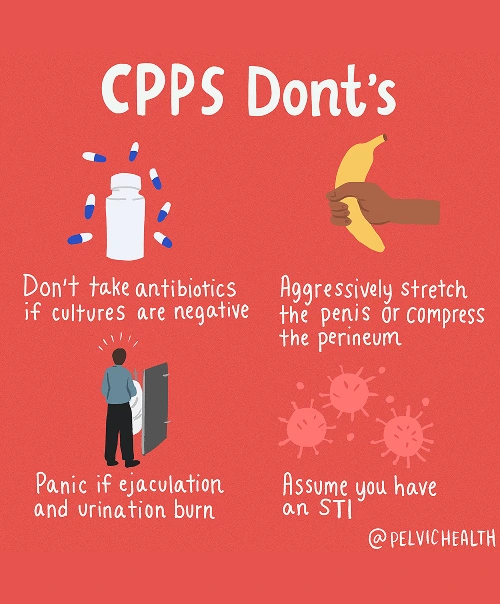
Instead, most cases fall under the National Institutes of Health (NIH) Category III classification of prostatitis, which refers to Chronic Prostatitis/Chronic Pelvic Pain Syndrome. The NIH categories are as follows:
- Category I: Acute bacterial prostatitis (true infection, sudden and severe)
- Category II: Chronic bacterial prostatitis (chronic infection, often with repeat UTIs)
- Category IIIa: Inflammatory CPPS (white blood cells seen on testing, but no bacteria)
- Category IIIb: Non-inflammatory CPPS (no white blood cells or infection, but symptoms are present)
- Category IV: Asymptomatic inflammatory prostatitis (inflammation without symptoms)
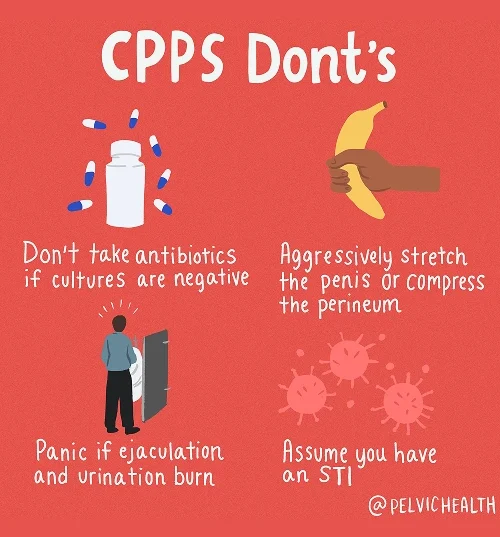
Because issues in the lower back or vascular system can closely imitate pelvic floor pain, many men go through testing that shows normal results. This lack of clear findings often leaves them without answers. As a result, men may spend months or even years going through repeated rounds of antibiotics, visiting multiple specialists, and feeling increasingly discouraged before finally learning that pelvic floor physical and occupational therapy can address the real underlying problem.
Symptoms of Chronic Pelvic Pain Syndrome
Because CPPS is rarely the result of an actual infection, the treatment process is quite different from simply taking antibiotics. The goal is to restore healthy function in the pelvic floor, reduce nerve sensitivity, and identify other systems in the body that may be adding to your discomfort.
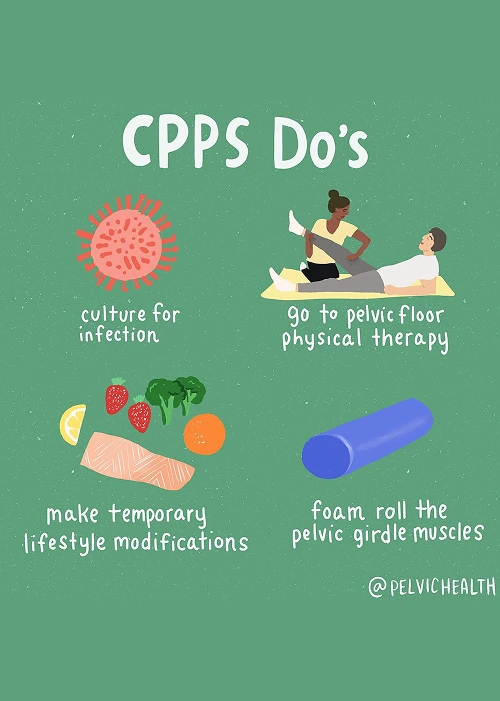
- Pelvic floor physical and occupational therapy: This remains the most important part of care for men with CPPS. Through targeted manual therapy and tailored exercises, therapy works to loosen tight pelvic floor muscles, retrain muscle control, and calm the irritated nerves responsible for pain and urinary symptoms.
- Spine and back treatment: If the nerves in your lower back or spine are influencing pelvic pain, therapy can help restore posture and movement while improving spinal alignment. Sometimes, your doctor may suggest injections to manage inflammation in that region.
- Vascular-related treatment: When restricted circulation contributes to your pain, pelvic floor therapy can improve blood flow, relax muscle tension, and ease pressure on congested veins by teaching optimal posture and breathing habits.
- Biomechanical support: Identifying and correcting imbalances in the hips or pelvis can reduce mechanical strain, allowing you to move more comfortably and lessen the overall stress on your lower body.
- Lifestyle adjustments: Practical strategies such as preventing constipation, reducing long hours of sitting, and reintroducing exercise gradually can all reduce pelvic strain and help prevent future flare-ups.
How We Can Help with Your Chronic Pelvic Pain
Men in Pasadena who struggle with chronic pelvic pain often spend months or even years looking for real answers. By the time you come to us, you may have tried several courses of antibiotics, received conflicting advice from different healthcare providers, and still find yourself living with the same frustrating symptoms. That’s where a detailed evaluation with one of our pelvic floor physical and occupational therapists who specialize in pelvic pain can truly make a difference.
When you come in for your evaluation at PHRC in Pasadena, your therapist will carefully go over your medical history and symptoms, review any previous diagnoses, and discuss the treatments you’ve tried in the past along with their results. We take this time because we understand that chronic pelvic pain affects more than just your body. It impacts your quality of life, energy, and confidence.
We also recognize how draining this entire process can be, which is why we listen closely and make sure you feel heard and supported throughout.
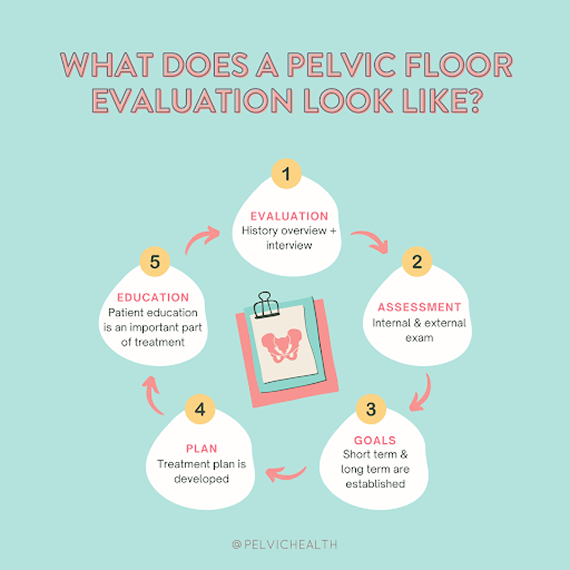
How We Can Help with Your Chronic Pelvic Pain
Men in Pasadena who struggle with chronic pelvic pain often spend months or even years looking for real answers. By the time you come to us, you may have tried several courses of antibiotics, received conflicting advice from different healthcare providers, and still find yourself living with the same frustrating symptoms. That’s where a detailed evaluation with one of our pelvic floor physical and occupational therapists who specialize in pelvic pain can truly make a difference.
When you come in for your evaluation at PHRC in Pasadena, your therapist will carefully go over your medical history and symptoms, review any previous diagnoses, and discuss the treatments you’ve tried in the past along with their results. We take this time because we understand that chronic pelvic pain affects more than just your body. It impacts your quality of life, energy, and confidence.
We also recognize how draining this entire process can be, which is why we listen closely and make sure you feel heard and supported throughout.
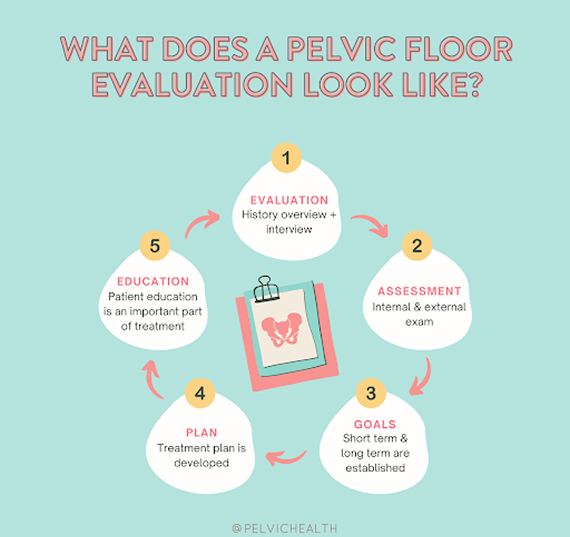
During your physical examination, your PHRC pelvic floor therapist will assess your muscles, tissues, joints, nerves, and overall movement patterns. Once your evaluation is complete, your therapist will review the findings with you and create a clear assessment explaining how your pain developed. Together, you’ll outline both short-term and long-term goals for your recovery plan.
Typically, pelvic floor physical and occupational therapy sessions occur one to two times per week for about twelve weeks. You’ll also receive a personalized home exercise program to support your progress between sessions. Your PHRC therapist will coordinate your care with other members of your healthcare team to ensure a comprehensive approach. Our goal is to help you finally find relief and take back control of your life.
